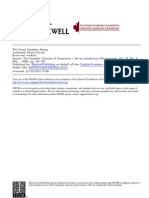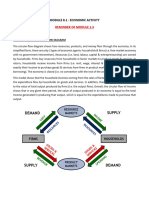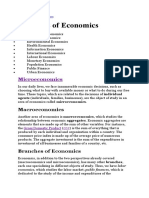The Determination of National Income: Households Firms
Uploaded by
rajkumarprpcThe Determination of National Income: Households Firms
Uploaded by
rajkumarprpcThe Determination of National Income
very simplified model only two sectors: households and firms factors of production factors that are necessary for the production of goods to take place Land, Labour and Capital the following transactions take place HOUSEHOLDS Own factors of production which they supply to firms Receive incomes from firms in exchange for supplying factors of production Spend money on goods and services produced by firms FIRMS Use factors of production supplied by households to produce goods and services Pay households for the use of factors of production Sell goods and services to households
households own the factors of production? Labour is understandable, but what about Land and Capital? Surely these belong to firms? households are the ultimate owners of firms
The Circular Flow Diagram
Household expenditure
Factors of production
Households
Goods and services
Firms
Factor incomes
household expenditure, factor incomes: MONETARY resources factors of production, goods and services: REAL resources
there are three ways to measure economic activity OUTPUT: value of goods (and services) produced INCOME: level of factor incomes EXPENDITURE: spending on goods and services three initial assumptions 1. firms sell only to households 2. no savings 3. households buy ALL goods and services produced by firms
Example Firms produce goods valued at 7,000 that they sell to households
Household expenditure 7,000
Households
7,000 Factor incomes
Firms
if all money is paid out to workers, why do firms produce at all? factor incomes will include the profits of firms ... and profits will make their way back to households because they are the ultimate owners of firms
more generally, the value of output produced by firms will always be matched by an equivalent flow of factor incomes from firms to households because we are measuring economic activity in terms of money, we will adopt the phrase national income
What happens when we relax the underlying assumptions? Assumption 1: more realistic to assume that transactions also take place between firms themselves firms may purchase raw materials from one another or buy machinery from other firms Value Added the increase in the value of goods as a result of the production process Final Goods goods purchased by their ultimate user -consumption goods purchased by households -capital goods (e.g. machinery) purchased by firms Intermediate Goods partly finished goods that form inputs to another firms production process and are used up in that process
how does this affect the measurement of national income? OUTPUT: net worth or value added INCOME: will reflect value added EXPENDITURE: final goods only Example Yachts PLC manufacture sail boats that they sell to their customers to produce these boats, Yachts PLC need to purchase timber and sail cloth (as raw materials) from their suppliers in addition to these raw materials, a woodcutting machine is also required by Yachts PLC to manufacture the sail boats
Good Timber Sail cloth Wood-cutting machine Yachts 6,500 9,900 500 1,400 500 6,500 7,000 1,500
Transaction
Expenditure
Value Added
Factor Incomes
1,500
1,500
1,400 500
1,400
500
3,600
3,600
7,000
7,000
Assumption 2: from this example we can clearly see that households must be saving. Whilst they are receiving 7,000 in factor incomes, they are spending only 6,500.
Household expenditure 6,500
Households
7,000 Factor incomes
Firms
we have already calculated national income to be 7,000, but spending by households is only 6,500 ... so somewhere in the economy there must be an additional 500 of spending if it is not coming from households it must be coming from the firms themselves
but whereas we denote the spending of households as CONSUMPTION expenditure, the purchases made by firms are referred to as INVESTMENT expenditure investment expenditure is the purchase of capital goods by firms do not confuse the term investment with the everyday use of the word, where individuals invest their money in stocks or shares Households consumption expenditure (C) Firms investment expenditure (I) so how does this affect our circular flow diagram?
S C
Households
Firms
Y I
pay careful attention to the direction of the arrows in the circular flow diagram (S)avings has an arrow pointing away from the system WITHDRAWAL (I)nvestment has an arrow pointing towards the system INJECTION is it just a coincidence that the level of savings and the level of investment are equal (both at 500)?
S=Y-C Y=C+S Y=C+I C+S=C+I S=I actual savings will always equal actual investment
Assumption 3: what will happen if firms are unable to sell all of their output? there will be a discrepancy between the output and expenditure methods of calculating national income the resolution to this problem lies in the treatment of INVENTORIES or STOCKS inventories are goods held by a firm for future production or sale Example Widgets Inc. produces 5,000 worth of widgets, of which it is only able to sell 4,000 worth to households. It adds the remaining 1,000 worth of widgets to its inventories. Produced: 5,000 Sold: 4,000 Inventories: 1,000
as it stands at the moment -output approach calculates national income at 5,000 -expenditure approach calculates national income at 4,000 inventories are treated as an investment in working capital and are classified as a capital good thus, inventory investment will appear as a final expenditure the expenditure approach will now calculate national income at 5,000: the 4,000 of final expenditure by households plus the 1,000 of investment expenditure as the firm adds to its inventories
The Government Sector
so far we have only dealt with a two-sector model now is the time to introduce a third sector: the government the government does not possess factor endowments that it can supply to firms in exchange for money income the government has the power to extract tax revenue to meet its spending needs for simplicity, we will assume that: -the only form of taxation is direct taxation (T), which is levied on the factor incomes of households -the only form of government expenditure is spending on the goods and services produced by firms (G)
S C G
Households
Government
T Y
Firms
(T)axes are a WITHDRAWAL from the system (G)overnment expenditure INJECTION into the system is an
the amount of money that households have available for spending an saving after taxes is termed personal disposable income Yd=Y-T S=Yd-C
S=(Y-T)-C Y=C+S+T since we can measure national income as the sum of all final expenditures Y=C+I+G C+S+T=Y=C+I+G S+T=I+G W=J
You might also like
- Christopher Leonard: The Lords of Easy Money: How The Federal Reserve50% (4)Christopher Leonard: The Lords of Easy Money: How The Federal Reserve7 pages
- Full download Macroeconomics 10th Edition N. Gregory Mankiw pdf docx63% (8)Full download Macroeconomics 10th Edition N. Gregory Mankiw pdf docx65 pages
- Microeconomic Theory Basic Principles and Extensions 12th Edition Nicholson Solutions Manual Download100% (18)Microeconomic Theory Basic Principles and Extensions 12th Edition Nicholson Solutions Manual Download13 pages
- Fortin - 1996 - The Great Canadian SlumpNo ratings yetFortin - 1996 - The Great Canadian Slump28 pages
- Thomas Sowell - Discrimination and Disparities (2018)100% (2)Thomas Sowell - Discrimination and Disparities (2018)369 pages
- (DAILY CALLER OBTAINED) - The State of The Working and Non-Working Man VF100% (1)(DAILY CALLER OBTAINED) - The State of The Working and Non-Working Man VF40 pages
- (Griffin, G Edward) The Creature From Jekyll Island (3rd Ed., 7th Printing, 1998)100% (22)(Griffin, G Edward) The Creature From Jekyll Island (3rd Ed., 7th Printing, 1998)315 pages
- Creature From Jekyll Island, Federal Reserve - BOOK SUMMARY100% (1)Creature From Jekyll Island, Federal Reserve - BOOK SUMMARY10 pages
- One Minute Millionaire by Mark Victor Hansen and Robert G. Allen - Excerpt64% (36)One Minute Millionaire by Mark Victor Hansen and Robert G. Allen - Excerpt27 pages
- Garment Industry: Pestle Analysis of Bangladesh and EthiopiaNo ratings yetGarment Industry: Pestle Analysis of Bangladesh and Ethiopia22 pages
- The Circular Flow of Income and National Income AccountingNo ratings yetThe Circular Flow of Income and National Income Accounting33 pages
- 8. the Level of Overall Economic ActivityNo ratings yet8. the Level of Overall Economic Activity116 pages
- WEEK 8b - NATIONAL INCOME ANALYSIS & InflationNo ratings yetWEEK 8b - NATIONAL INCOME ANALYSIS & Inflation19 pages
- TOPIC 2 PRINCIPLES OF MACROECONOMIC THEORYNo ratings yetTOPIC 2 PRINCIPLES OF MACROECONOMIC THEORY6 pages
- Simple Keynesian Model: National Income Determination Two-Sector National Income ModelNo ratings yetSimple Keynesian Model: National Income Determination Two-Sector National Income Model33 pages
- Session 1 & 2 - Introduction and National Income AccountingNo ratings yetSession 1 & 2 - Introduction and National Income Accounting73 pages
- Introduction To Macroeconomics: - Introduction and Overview - The Circular Flow of Income, Expenditure and OutputNo ratings yetIntroduction To Macroeconomics: - Introduction and Overview - The Circular Flow of Income, Expenditure and Output27 pages
- Some Basic Concepts of Macroeconomics 1No ratings yetSome Basic Concepts of Macroeconomics 136 pages
- Ch2 Some Basic Edited Concepts of MacroeconomicsNo ratings yetCh2 Some Basic Edited Concepts of Macroeconomics26 pages
- Macroeconomics (ECO 101) : National Economy and National Income AnalysisNo ratings yetMacroeconomics (ECO 101) : National Economy and National Income Analysis23 pages
- Unit 7A National Product and Its Measurement BitinfonepalNo ratings yetUnit 7A National Product and Its Measurement Bitinfonepal57 pages
- National Income and Related Aggregates 1No ratings yetNational Income and Related Aggregates 110 pages
- Very Awkward Tax: A bite-size guide to VAT for small businessFrom EverandVery Awkward Tax: A bite-size guide to VAT for small businessNo ratings yet
- GST: Practical Aspects for Business Owners, Accountants, and Professionals: Part 1, #1From EverandGST: Practical Aspects for Business Owners, Accountants, and Professionals: Part 1, #15/5 (1)
- Economics in One Lesson by Henry Hazlitt - Excerpt14% (261)Economics in One Lesson by Henry Hazlitt - Excerpt18 pages
- Kindleberger Has Discussed Eight Effects of Tariff On The Imposing Country100% (1)Kindleberger Has Discussed Eight Effects of Tariff On The Imposing Country3 pages
- The 20 Rules of Money - Patrick Bet-DavidNo ratings yetThe 20 Rules of Money - Patrick Bet-David8 pages
- Kathi Weeks, The Problem With Work Feminism, Marxism POSTWORK100% (2)Kathi Weeks, The Problem With Work Feminism, Marxism POSTWORK300 pages
- Basic Economics A Citizen's Guide To The Economy91% (23)Basic Economics A Citizen's Guide To The Economy379 pages
- Understanding The Operations of Freight Forwarders - Evidence Froom SerbiaNo ratings yetUnderstanding The Operations of Freight Forwarders - Evidence Froom Serbia32 pages
- ap-microeconomics-2017-international-practice-exam-frq-scoring-guidelines100% (1)ap-microeconomics-2017-international-practice-exam-frq-scoring-guidelines5 pages
- Paper:: 11, Managerial Economics 11, The Production TheoryNo ratings yetPaper:: 11, Managerial Economics 11, The Production Theory16 pages
- MGMT 432 - Operations Management AssignmentNo ratings yetMGMT 432 - Operations Management Assignment10 pages
- Determination of National Income - Unit I - National Income AccountingNo ratings yetDetermination of National Income - Unit I - National Income Accounting34 pages
- Model Question Paper Cost and Management Accounting100% (1)Model Question Paper Cost and Management Accounting6 pages
- Macroeconomics 9th Edition Mankiw Solutions Manual Download100% (21)Macroeconomics 9th Edition Mankiw Solutions Manual Download20 pages
- Macroeconomics Canadian 7th Edition Abel Test Bank - All Chapters Are Available In PDF Format For Download100% (2)Macroeconomics Canadian 7th Edition Abel Test Bank - All Chapters Are Available In PDF Format For Download50 pages
- Macro - Economics Presentation: SUBMITTED TO:-Mrs - Veena GroverNo ratings yetMacro - Economics Presentation: SUBMITTED TO:-Mrs - Veena Grover4 pages
- Generic Elective Introductory Macroeconomics Unit I & II (Lesson 1-10)No ratings yetGeneric Elective Introductory Macroeconomics Unit I & II (Lesson 1-10)119 pages
- Chapter 1 Intro To Macro and Measuring Macro VariablesNo ratings yetChapter 1 Intro To Macro and Measuring Macro Variables87 pages
- Aggregate Demand (AD) : AD and AS OnlineNo ratings yetAggregate Demand (AD) : AD and AS Online52 pages
- Namma Kalvi 12th Economics Full Study Material em 220304No ratings yetNamma Kalvi 12th Economics Full Study Material em 220304116 pages
- Lecture 5 - Marginal Costing Differential Cost AnalysisNo ratings yetLecture 5 - Marginal Costing Differential Cost Analysis2 pages























































































































